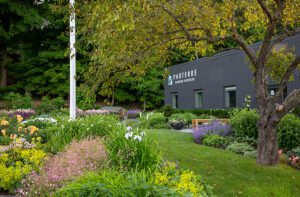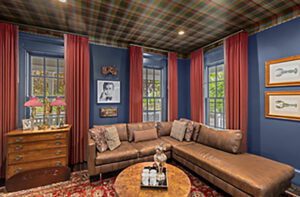The More Things Change …
March 26, 2015
A treasured family retreat is refreshed and revived, but remains the same home that has provided happy memories for generations.
Text by Maria LaPiana Photography by Robert Benson
The house stood for a lifetime on high ground in northwestern Connecticut, on a plot of rolling farmland that had been largely reforested over the years. The wood-clad summer home—some would call it a cabin, a cottage, a camp—was built in 1928 in a clearing in the woods. It had settled, uninterrupted, into its site when architect Jacob Albert assessed it five years ago. “Rock outcroppings are a big part of the character of the land,”
says Albert, “and the stone of the foundation and chimneys seems to grow out of the rocks.”
Indeed, says owner Roxana Robinson, a novelist and biographer who frequently does her writing here. The house belonged to her grandparents, and her grandfather had been highly attuned to nature, she says. Many native woods and stones were used in construction of the home.
The dwelling was a welcome retreat in warm weather, but when Robinson and her husband became sole owners six years ago, they decided to make a few practical improvements. “We wanted to winterize it, but otherwise change it as little as possible,” she says.
In all the ways that mattered, they wanted to keep the home intact.
Albert, a principal of the Boston firm Albert, Righter & Tittmann Architects, respected the lineage of the home. It was designed by Ruth Maxon Adams, an informally trained architect (women were not permitted to practice architecture back in her day) who had designed nine other houses in the area. The distinctive building has a “picturesque composition, small-paned casement windows, wide clapboards, and rustic details characteristic of Adams’s work,” says Albert, who took on the project with colleagues J.B. Clancy and Jim Righter. “We were committed to honoring and augmenting this existing character.”
For year-round comfort, the team gutted the inside and insulated the walls. The 3,600-square-foot house also underwent a few functional changes to the floor plan. The design included a new entry porch, entry hall, and mudroom. A separate garage with a writer’s studio was built in a compatible style with similar materials.
In keeping with Robinson’s wishes, original materials were saved and reused. Fireplace surrounds made of native stone were left alone, for example. “The floors of white birch—unusual as a building material—were preserved,” says Robinson. She remembers that contractor George T. Charleton was so conscientious he made sure to find some rare white birch to match the floors in the new entry hall.
Even elements that were less than ideal were preserved. The upstairs hall’s quirky interior windows, for instance, compromise privacy, but they stayed. Robinson was advised to replace the French doors in the living room with windows, but that would have altered an important architectural detail, so the doors still stand. All of the old natural wood trim, as well as doors and their hardware, remained in place, too. The interiors were furnished under the guidance of New York City interior designer Kerry Wilson, who says the house is a reflection of the homeowners. “I helped them with paint colors, fabrics,” says Wilson. “We repurposed some pieces and moved others. This home had belonged to Roxana’s grandparents, and my role was to help re-imagine it for her.”
The brown-stained, rough-sawn wide clapboards of the exterior were retained. Many of the wood-framed casement windows, now trimmed in white, were saved, and new ones were made to look just like the old.
The only obvious alteration to the facade came when the recessed entry porch was enclosed to create the new entry hall, and a true porch was added. Constructed of timbers from an old oak tree that grew on the site, the new porch “improves the relationship with the outdoors,” says Albert. The worn asphalt of the roof was replaced with cedar shingles for a more authentic look.
Noted landscape architect Patrick Chassé was responsible for the natural landscape design. “It was important to keep the woodsy, unmanicured feeling of the site,” says Albert, even while building a garage and improving the driveway and access to the house.
The old house is still a rustic camp with rough-hewn beams and craggy stone chimneys, but, he says, “it has the comforts and amenities of home.”
Robinson confesses that the remodeling process was a bit stressful. “I know how much my mother loved the house,” she says. “We were very, very careful about making changes.”
Now that it’s finished, though, she’s pleased to know that she has preserved “the contextual fabric” of the home she enjoyed as a child.
Share
![NEH-Logo_Black[1] NEH-Logo_Black[1]](https://b2915716.smushcdn.com/2915716/wp-content/uploads/2022/08/NEH-Logo_Black1-300x162.jpg?lossy=1&strip=1&webp=1)















You must be logged in to post a comment.